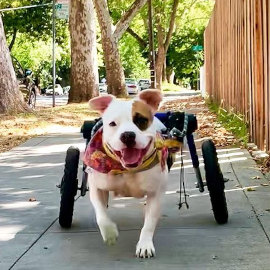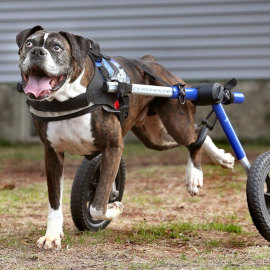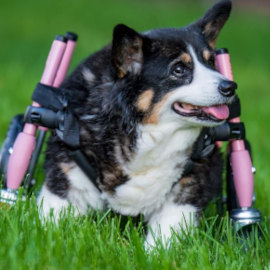6 Reasons to Use a Dog Wheelchair
By admin / December 16, 2022 / No Comments / Uncategorized
The uses of a dog wheelchair go far beyond a pet who can no longer walk. It may sound surprising, but a wheelchair can be just as beneficial for a dog who can still walk as it can for a paralyzed dog.
As dogs age, it’s common for their bodies to slow down, sleep more often, take a little longer to stand up, and tire easily. These are all signs that a dog’s mobility is changing and often the first indicators that your dog needs some mobility assistance. Here are a few of the most common uses for a dog wheelchair.
1. Senior dogs who get tired on long walks

For formerly active dogs, missing out on their favorite activities or getting too tired to go on their long walk can impact their emotional well-being. Not only are they not getting the amount of exercise they’re used to, but they’re missing out on time spent with their family.
Introducing your dog to a wheelchair early can help your dog continue to enjoy taking a long walk. Dog wheelchairs provide support underneath your dog’s hind legs to reduce the pressure on the rear limbs, making it easier for them to walk. However, a dog wheelchair will not make your dog lazy, and it doesn’t mean your dog needs to use a wheelchair all the time, just when they are doing a strenuous activity where they will tire quickly. It just means your giving your dog the tools they need to stay active and healthy.
2. Pets with shaky or weak back legs
Shaking back legs indicates your dog is losing strength in their hind end. The shaking may be sporadic and occur after a dog has been highly active or when it has been standing for long periods. But shaky back legs are a sign that your dog needs hind-end support. On “bad days,” your dog can use a wheelchair for added stability.
3. Pets struggling with balance issues
As pets age, many experience a change in their equilibrium, causing them to lose balance suddenly. A wheelchair can help your pet maintain balance and give them the additional support they need to stay on their feet. In addition, pets diagnosed with a neurological condition that impacts their motor function and balance will benefit from a full support dog wheelchair. A full support cart supports a dog’s entire body with two front and two back wheels.
4. Sudden paralysis

Pet paralysis is one of the most common reasons a dog needs a wheelchair. Often, sudden paralysis occurs from a mobility condition such as IVDD or even a traumatic injury. Although, in many instances, pet parents are unaware of how to help a pet who suddenly can’t walk, luckily, many tools are available, and paralysis is no longer an end-of-life decision.
A rear dog wheelchair will support a paralyzed dog, allowing it to stand upright and move the way it did before its injury or diagnosis. A newly diagnosed paralyzed pet will spend more time in a prone position and often struggle to get the necessary exercise, which is why a wheelchair is a vital part of their rehabilitation. In addition, the ability to exercise again will improve your pet’s emotional state, lower the likelihood of depression, help your pet maintain a healthy weight, minimize muscle atrophy, and help its internal processes return to normal function.
5. Diagnosed with a degenerative condition that impacts mobility

By nature, a degenerative condition, such as DM, affects a pet’s mobility over time. The first signs are often subtle changes, such as dragging back paws or struggling to stand after resting. As the condition progresses, the signs of mobility loss become more apparent with an inability to bear full weight on their back legs or causing their back legs to collapse suddenly.
Dogs diagnosed with progressive mobility loss will need a dog wheelchair eventually. To help ease the transition into relying on a mobility cart, pet owners should get a wheelchair early on. Introduce the cart into your daily walk, use it for quick bathroom breaks, and allow your pet to adjust to having a wheelchair. Also, choose a wheelchair that can adapt to your pet’s changing mobility needs. For example, dogs with DM experience hind leg paralysis first but that mobility loss will travel up the spine to impact their front legs as well. An adjustable wheelchair can easily convert to a full support wheelchair when your pet is ready.
6. Additional support for rear amputee pets

Dogs adjust well to missing a limb. But you may not realize that to compensate for its missing leg, an amputee dog puts a lot of strain on their remaining hind leg.
Over the years, the dog’s healthy back leg experiences a lot of wear and tear, placing it at high risk of arthritis as it ages. A rear wheelchair can help an amputee pet distribute its weight more evenly and reduce the pressure on one leg.
In Conclusion
There is no one reason why a dog needs a wheelchair. How to use a dog wheelchair depends on the dog’s unique needs. Some pets will only use a wheelchair on bad days, while others use a wheelchair all the time. So often, pet parents say, “I wish I had gotten my dog a wheelchair years ago.” Don’t wait. A dog in motion is more likely to stay in motion. Using a cart early can promote exercise, help your pet stay healthy, and minimize the risk of muscle atrophy. So keep your dog as active as possible with the support of a dog wheelchair.

